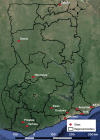Mosquito breeding water parameters are important determinants for Microsporidia MB in the aquatic stages of Anopheles species
- PMID: 39695866
- PMCID: PMC11657153
- DOI: 10.1186/s13071-024-06596-9
Mosquito breeding water parameters are important determinants for Microsporidia MB in the aquatic stages of Anopheles species
Abstract
Background: Microsporidia MB disrupts Plasmodium development in Anopheles mosquitoes, making it a possible biocontrol tool for malaria. As a tool for vector/disease control, its ecological distribution and the factors that determine their occurrence must be defined. We investigated the frequency of Microsporidia MB in Anopheles mosquitoes across selected sites in northern and southern Ghana, as well as the physicochemical parameters of mosquito breeding water that are associated with the occurrence of the fungus, by fitting regression models.
Methods: A non-column extraction method was used to extract DNA from the abdomens of 4255 adult Anopheles mosquitoes that emerged from larvae and pupae collected between August and October of 2021 and 2022. Detection of Microsporidia MB was achieved using quantitative PCR (qPCR), while mosquito species were molecularly identified using short interspersed nuclear elements (SINE), restriction fragment length polymorphism (RFLP) methods, and the ANOSPP algorithm.
Results: Overall Microsporidia MB distribution was 2.2% (92/4255). Male mosquitoes exhibited a higher frequency of infections and had a predicted probability of infection that was 85% higher than that of females. Sites in Ghana's Savannah zone had the highest Microsporidia MB distribution (68.5%). Biochemical oxygen demand in mosquito breeding water was estimated to be positively associated with and significantly predicts Microsporidia MB in mosquitoes with an accuracy of 94%. Increasing ammonium ion concentrations reduced the chances of finding Microsporidia MB-positive mosquitoes. According to our data, all Anopheles mosquitoes, including minor species such as An. squamosus, An. pretoriensis and An. rufipes, had equal probability of Microsporidia MB infection.
Conclusions: These results provide preliminary information on micro-ecological factors that potentially support the sustainability of Microsporidia MB infection in mosquitoes during their aquatic life stages. It will be important, therefore, to explore the impact of strategies for larval source management on these factors to ensure that the symbiont's persistence during the host's aquatic stages may not be adversely affected should it be used as an integrated approach for mosquito/disease control.
Keywords: Anopheles mosquitoes; Microsporidia MB; Mosquito breeding site; Physicochemical parameters.
© 2024. The Author(s).
Conflict of interest statement
Declarations. Ethics approval and consent to participate: Not applicable. Consent for publication: Not applicable. Competing interests: The authors declare no competing interests.
Figures






References
-
- Bukhari T, Pevsner R, Herren JK. Microsporidia: a promising vector control tool for residual malaria transmission. Front Trop Dis. 2022;3:957109.
MeSH terms
Substances
Grants and funding
LinkOut - more resources
Full Text Sources
Research Materials
Miscellaneous

